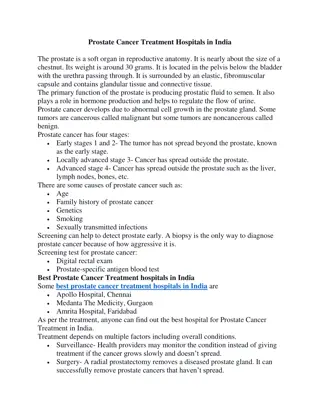Prostate Cancer
The walnut-sized prostate gland, risk factors, and screening methods for prostate cancer. Learn about age, family history, ethnicity, and lifestyle influences on the disease. Discover the importance of PSA blood tests, DRE examinations, MRI scans, and biopsies in diagnosing and grading prostate cancer.
Download Presentation

Please find below an Image/Link to download the presentation.
The content on the website is provided AS IS for your information and personal use only. It may not be sold, licensed, or shared on other websites without obtaining consent from the author.If you encounter any issues during the download, it is possible that the publisher has removed the file from their server.
You are allowed to download the files provided on this website for personal or commercial use, subject to the condition that they are used lawfully. All files are the property of their respective owners.
The content on the website is provided AS IS for your information and personal use only. It may not be sold, licensed, or shared on other websites without obtaining consent from the author.
E N D
Presentation Transcript
A walnut-sized gland located between the bladder and the penis The urethra runs through the centre of the prostate
The vas deferens bring sperm from the testes to the seminal vesicles. The seminal vesicles contribute fluid to semen during ejaculation. The prostate secretes fluid that nourishes and protects sperm. During ejaculation, the prostate squeezes this fluid into the urethra, which is expelled with sperm as semen.
In the UK Most commonly diagnosed cancer in men More than 52,000 men are newly diagnosed with prostate cancer each year Around12,000 men die from prostate cancer each year With a 78% survival at 10years over 250,000 men are living with the disease Locally 383 new prostate cancer diagnosed, this is a 26% increase on previous year.
Age Men aged >50 years Risk increases with age Average age for diagnosis 70-74 years Family History 2 and a half times more likely to develop prostate cancer if father/brother had the disease This risk increases if the family member was aged <60 years at diagnosis Ethnicity In the UK, Afro-Caribbean men are twice as likely to develop prostate cancer than white men of the same age 1 in 8 White men, 1in 4 Black men, 1in 12 Asian men Lifestyle Unknown- it is thought that a healthy lifestyle and diet may be important in protecting against the disease Age Family History Ethnicity Lifestyle
Well man clinic/Private Healthcare Screening Patient requested PSA blood test Family History on PSA surveillance Urinary symptoms Feeling unwell/back pain
Blood Test PSA (prostate-specific antigen) Examination DRE (digital rectal examination) MRI scan- prior to biopsy to be able to target biopsy to abnormal areas Biopsy TRUS/TP Biopsy (trans-rectal ultrasound/ Trans-perineal) Pathologists grade prostate cancer using the Gleason Score (6-10) or grade group 1-5 Imaging CT Bone scan
Active Surveillance (grade group 1-2) PSA monitoring, MRI scans, repeat Biopsies at interval as needed. Benefits- no side effects from treatment Risks- psychologically difficult for some patients Progression of disease while on surveillance (low risk as patients at higher risk, not offered surveillance
Removal of all the prostate and prostatic urethra- usually robot assisted Risks- urinary incontinence- recovery 4-3 months- pelvic floor exercises recommended. Erectile dysfunction- 6-12 month recovery with use of PDE-5 inhibitors, patients may need additional treatments, such as injections. Risks of anaesthetic Benefits- can confirm grade of cancer and surgical margins PSA should be undetectable- if PSA increases, can give salvage radiotherapy
Usually external beam radiotherapy Given with hormones to lower testosterone level- this reduces size of prostate and treats prostate cancer, so cancer cells not active when radiotherapy given. Length of hormone treatment depends on grade of cancer 20 days of treatment Risks- side effects of hormones Potential damage to bladder and bowel, leading to lower urinary tract symptoms and changes in bowel pattern. Benefits- overall survival and progression free survival same of surgery Avoids anaesthetic risk
Commonly spreads to lymph nodes or bones Treatment options: Primary hormone manipulation (tablets/injections/surgery- removal of testes) Referral to Oncology to offer up front chemotherapy or other hormone tables Depending of response to treatment- may also have radiotherapy for local control Palliative radiotherapy to bone for pain Newer medications, such as Olaparib for BRCA 1 and 2 mutations in metastatic, hormone resistant disease. Treatment response is measured by regular PSA monitoring and repeat imaging as clinically indicated
www.macmillan.org.uk www.prostatecanceruk.org www.birminghamcancer.nhs.uk www.cancerresearchuk.org























